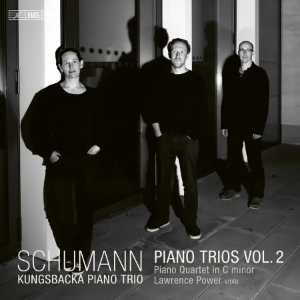
Robert Schumann (1810-1856)
Piano Trio No 3 in G minor, Opus 110 (1851)
Sechs Studien in Kanonischer Form, Opus 56 (1845, arr. Theodor Kirchner)
Piano Quartet in C minor (1829)
Kungsbacka Piano Trio
Lawrence Power (viola)
rec. 2019, Potton Hall, Westleton, UK; 2022 Berwaldhallen, Stockholm, Sweden (quartet)
BIS BIS2477 SACD [78]
This disc is a must for Schumaniacs (to borrow Steven Isserlis’s coinage). The Third Trio, probably the least-known of the three, is joined by two curiosities. The C minor Piano Quartet was the first full-length work by Schumann, who was then an eighteen-year-old law student in Leipzig. Its massive first movement immediately throws us into a passionate, quasi-orchestral cauldron. (“The quartet will be cobbled into a symphony”, Schumann wrote). It’s a fascinating piece, full of character – a brilliant scherzo, an engaging slow movement and a finale propelled by the kind of rhythmic obsessiveness which would become a hallmark of Schumann’s music. It sounds as though it must be great fun to play. Of course it is raw and often unsubtle, but its youthful enthusiasm is thrilling in its own way. It is performed so winningly and artistically that I cannot imagine a stronger case being made. Each player is fervently committed but the special sensitivity of Simon Crawford-Phillips struck me more than once. Apparently the piano part was left incomplete and is here edited by Joachim Draheim.
Schumann composed the Studies Opus 56 for pedal piano, an instrument he believed to be of exciting potential and which he promoted among colleagues. Lest anyone imagine these studies as in any way unrepresentative, I would emphasise their musical quality and ask why Debussy would have made an arrangement for two pianos if he hadn’t admired them. Theodor Kirchner, a fellow-student of Schumann’s in Leipzig, arranged the studies for piano trio in a version which clarifies the contrapuntal writing. When I use the word “curiosity”, I mean no more than to describe their unfamiliarity. Kirchner also arranged Brahms’s two sextets for piano trio.
The Kungsbacka (named after a Swedish town where the trio made its debut, a half-hour journey from Gothenburg,) have previously recorded Haydn and Schubert, Fauré and Chopin. In the first movement of Opus 110 (what a piece – no sign of the alleged decline in Schumann’s later years) the trio combine passion and elegance, and fire with culture, while capturing the underlying turbulence. The slow movement, played most tenderly, without sentimentality, has a rhythmically pointed, strongly contrasting middle section and here the fiery character is ideally realised. Following the third movement with its two trios, played with lovely buoyancy, the joyful, dance-like quality of the finale is exuberantly expressed.
Stephen Johnson’s booklet notes tend to wordiness and are sometimes overthought, as though he is determined to find deeper meaning in the music. I simply cannot understand his description of the finale as “weirdly inappropriate”, and his further comments seem to me equally misguided but – to be less subjective – he is informative about the background to each piece and regarding the pedal piano. The recorded sound is beautifully natural.
Philip Borg-Wheeler
Help us financially by purchasing from




















